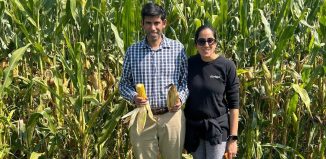Working to make nuclear plants safer
That self-described slow jogger who makes his way back and forth along Old Field Road five days a week — when he’s not in high-level meetings in Austria or Japan — just might be making everyone safer. That’s especially true for those people who live or work near nuclear power plants.
A condensed-matter physicist at Brookhaven National Laboratory, Robert Bari specializes in the kinds of “what if” scenarios scientists, policymakers and government officials need to consider when building, maintaining, and running the country’s nuclear power plants.
Bari is one of 22 people on a committee studying the lessons learned from the Fukushima power plant meltdown, which occurred two years ago in March following an earthquake that triggered a deadly tsunami. The committee, created by the National Academy of Sciences, will present its findings to Congress next spring.
“I visited Fukushima last November and talked with officials from the plant, from government and with the public,” Bari said. “We had open and closed meetings as appropriate.”
A physicist at Brookhaven since 1971 (with a year at Stony Brook as a visiting professor), Bari brings his expertise in nuclear power reactor safety, security and proliferation resistance to the committee.
Recently elected as a fellow of the prestigious American Physical Society, Bari has developed a career around probabilistic risk assessment and methods for analyzing proliferation resistance. He does severe accident analysis, mainly for nuclear power plants, but also for other nuclear fuel cycle facilities. He has also performed analyses of ship safety for the Navy and electrical grid performance for the Department of Energy.
In the immediate aftermath of Fukushima, he spoke with officials at the DOE at least weekly. He contributed as a part of a briefing for the Secretary of Energy and the president’s science adviser, who attended at least two presentations.
Robert Budnitz, a physicist at the Lawrence Berkeley National Laboratory at the University of California, said Bari’s role on the NAS committee is well-deserved and earned.
Bari is “an analyst who is more likely than most to come up with an imaginative answer,” Budnitz added. Bari can consider a design problem and, more effectively than most, figure it out, Budnitz said.
Bari gained experience in March of 1979, after the Three Mile Island accident. He built a risk-assessment capability for other plants. He eventually led a division of 60 people who specialized in “what can go wrong in a U.S.-type facility; what are the consequences, physical parameters and human factors involved in those types of activities,” he said.
Through his career, he said he’s been involved in studying nuclear safety and nuclear reactors through a range of responsibilities, from managing large teams to serving as associate lab director and department chair.
Budnitz said nuclear power plants are safer today than they were when many of them were built in the 1970s. The reason is that there a few dozen people worldwide who have worked to improve their design. “[Bari’s] in the middle” of that group and is “one of the most respected” contributors, Budnitz said.
A decade ago, the U.S. and 12 other countries got together to discuss the design of the next set of nuclear facilities, called Generation IV reactors. The Generation IV members discussed design plans for the commercial introduction of new nuclear plants from 2015 to 2030 and beyond.
As the co-chairman of the proliferation-resistance and physical protection group, Bari is responsible for increasing the assurance that the reactors are unattractive and the least desirable route for diversion or theft of weapons-usable materials, and to provide increased physical protection against acts of terrorism.
The Generation IV discussions started before 9/11, but took on a different urgency and design component when potential terrorism became a concern.
Bari lives in Setauket with his wife, Angela Bari, who is an instructor at the Osher Lifelong Learning Institute at Stony Brook, where she teaches courses in physics and on the history and holdings of the Metropolitan Museum. The couple have two children, Robin Sanchez, who works in a media company, and Robert Bari, who is an agent for Aflac Insurance.
As for his work, Bari recognizes that his scientific approach isn’t the typical “publish or perish” paradigm. “I like to think at the end of the day that we’re doing something that is for the public good and also creating new knowledge. I always ask myself ‘Have I created new knowledge?’”






